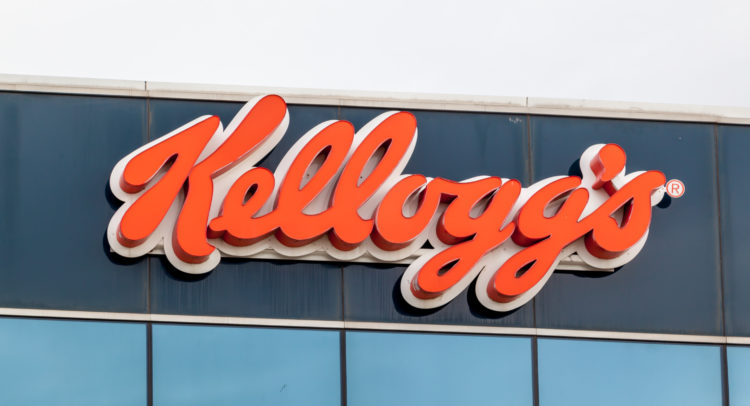For years, Kellogg Company stock (NYSE: K) has been a go-to investment for those seeking dividends. However, despite the stock’s impressive performance in 2022, outpacing the market with a 14% total return compared to the S&P 500’s (SPX) 19% loss, its share price is currently hovering close to the same levels it did near the end of 2015. Nonetheless, Kellogg has remained committed to annual dividend increases, with its dividend yield currently standing at 3.4%. Therefore, the stock may not be worth it for growth investors, but conservative dividend investors might appreciate its stability.
Meet Your ETF AI Analyst
- Discover how TipRanks' ETF AI Analyst can help you make smarter investment decisions
- Explore ETFs TipRanks' users love and see what insights the ETF AI Analyst reveals about the ones you follow.
Kellogg’s Earnings Growth Potential is Limited
To figure out Kellogg’s dividend growth prospects, it’s first worth looking into the company’s earnings growth prospects. Well, unfortunately, Kellogg’s earnings growth has been quite underwhelming over the years. While its renowned brands — which, among others, include Pringles, RXBAR, Bear Naked, Eggo, and Special K — tend to generate robust sales, they are also incredibly mature. Indeed, the company has already penetrated many markets.
So other than any inflation-linked price hikes or accretive acquisitions, it has been incredibly hard over the past decade for Kellogg’s to grow its top-line revenue. To shed some light on this, the company generated sales of $14.2 billion in 2021, precisely the same amount it generated back in 2012. Due to stagnated revenues, the only two drivers that have contributed to earnings-per-share growth have been a modest expansion in margins and stock buybacks.
Specifically, over the past decade, Kellogg’s net income margin has expanded from mid-single digits to low-double digits, while management has repurchased and retired about 5.5% of the company’s outstanding shares.
Kellogg is expected to release its Q4-2022 earnings results in early February. Investors’ expectations, along with the company’s performance during the first nine months of the year, point toward another year of stagnated performance.
For example, through the first nine months of 2022, earnings per share rose by just 0.7% to $3.09 year-over-year. This was due to unfavorable mark-to-market impacts and adverse currency translations, which were thankfully offset by an enhanced effective tax rate. Accordingly, the company is expected to report earnings per share of $4.14 for fiscal 2022, pretty much flat compared to the prior year.
Uninspiring Dividend Growth Prospects
Navigating Kellogg’s dividend growth has been a delicate balancing act for the company’s management team. On the one hand, it strives to maintain Kellogg’s strong dividend-growth track record, which now counts 18 years of consecutive annual dividend increases. On the other hand, meaningfully boosting the dividend with limited earnings growth could push the payout ratio to concerning heights.
As a result, while Kellogg’s dividend has been growing year after year, the pace of its growth has been decelerating continuously. For context, Kellogg’s five-year dividend-per-share compound annual growth rate stood at about 8% back in 2011. At the end of last year, it stood at just about 2.5%. Further, Kellogg’s most recent dividend increase was the most underwhelming to date, with the company raising its dividend by just 1.7% (or one penny per share) to a quarterly rate of $0.59/share.

While prudent dividend growth has prevented Kellogg’s payout ratio from reaching unsustainable levels, the metric has still been worsening gradually over time. It stood at 48% a decade ago and now stands at 57% based on the aforementioned expected earnings per share estimates for the year. In my view, as long as Kellogg lacks meaningful growth drivers, management will likely resort to continuing to grow payouts at a very uninspiring rate in order to preserve and expand the company’s dividend-growth track record.
Kellogg’s Valuation Isn’t Cheap
In my view, Kellogg’s current valuation sufficiently reflects the company’s low dividend growth potential while taking into account the packaged food giant’s overall qualities. Based on 2022’s expected earnings per share, the stock’s forward P/E ratio currently hovers close to 16.8x. That’s not a cheap multiple (it implies a modest 5.95% earnings yield) for a company whose earnings per share could, at best, grow in the mid-single digits moving forward, especially in a rising-rates environment. And that’s an optimistic scenario, as inflationary pressures could suppress earnings growth.
Nevertheless, investors are likely to continue to assign a premium multiple to Kellogg shares, as its trusted brands are set to keep performing in a highly-predictable manner, which is highly appreciated, especially during an uncertain trading environment like the one we are presently experiencing.
Is Kellogg Stock a Buy, According to Analysts?
As far as Wall Street’s sentiment goes, Kellogg has a Moderate Sell consensus rating based on five Holds and three Sells assigned in the past three months. Nonetheless, at $69.38, the average Kellogg stock price target implies 3% upside potential.

The Takeaway – A Stock for Conservative Investors
Kellogg stock likely remains a decent pick for very conservative investors looking to collect a reliable stream of dividends. While the company’s revenue and earnings growth prospects are definitely hard to excite anybody, the dividend remains well-covered, and payouts are likely to keep growing slowly but consistently.
Nevertheless, it’s hard to see how the stock could benefit most other investors as, besides its 3.4% yield (which is hardly compelling on its own), Kellogg’s upside potential appears to be limited – especially given that its valuation is nowhere near cheap.
















